The History of Powerlifting
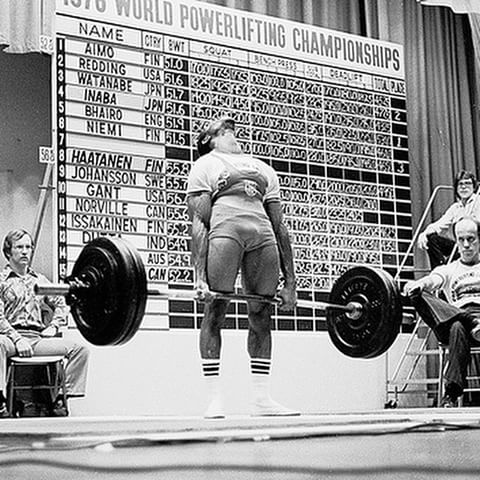
The History of Powerlifting
Powerlifting is a strength sport that consists of three attempts at maximal weight on three lifts: squat, bench press, and deadlift. There has been a great deal of confusion relating to the origins and roots of powerlifting. The conflict which has enveloped it in recent years hasn’t helped to clarify it very much.
The deadlift is the oldest, having been a pet lift of professional strongman Herman Goerner of South Africa in the 1920s. It was used as an assistance exercise in the intervening years before Bob Peeples of the United States matched Goerner’s level in the 1950s.
Squatting was first popularised by Italy’s Marquis Alfred Pallavicini and then more famously performed by pro strongman-wrestlers Milo Steinborn and Bert Assirati in the 1930s and 1940s. After Steinborn the weightlifting world would have to wait for the arrival of Canada’s Doug Hepburn and the USA’s Paul Anderson in the 1950s before 600lb (272.5kg) squats were again performed.
The bench press was a little-known exercise until the late 1940s. It was probably helped a bit by its use in rehabbing soldiers injured in World War II. Again, it took off in the 1950s with superb performances by Hepburn and Marvin Eder.
Very few people are still around who were in on the beginning of powerlifting as it started back in about 1948. Basically, powerlifting is as old as man and down through the ages there have been a great many powerlifters, depending on your interpretation of what powerlifting is. Most of the old-time strongmen could be classed as powerlifters. Such men as Louis Cyr, Hermann Goerner, Josef Steinbach, Wilhelm Turk, Karl Swoboda, Warren Lincoln Travis, G.W. Rolandow, Lionel Strongfort and there are a large number of other similar famous strongmen who exhibited their strength in the past, primarily as professionals, that they might make a living at it.
The roots of powerlifting are in traditions of strength training stretching back as far as Greek and Roman times. The modern sport originated in the United States and the UK in the 1950s. Previously, the weightlifting governing bodies in both countries had recognised various ‘odd lifts’ for competition and record purposes. During the 1950s, Olympic weightlifting declined in the United States, while strength sports gained many new followers. In 1958, the AAU’s National Weightlifting Committee decided to begin recognising records for ‘odd lifts’. A national championship was tentatively scheduled for 1959, but it never happened. The first genuine national ‘meet’ was held in September 1964 under the auspices of the York Barbell Company. Ironically, Bob Hoffman, the owner of York Barbell, had been a long-time adversary of the sport. But his company was now making powerlifting equipment to make up for the sales it had lost on Olympic-style equipment.
Eventually odd lifts became standardised to the current three, but in the past there were many more, and even now in the Odd Lift Strength Association lifters compete at the following disciplines:
One Arm Dumbbell Cheat Curl, One Arm Dumbbell Clean and Press, One Arm Snatch, One Finger On Each Hand Dead Lift, One Hand Clean and Jerk, One Hand DeadLift, One Hand-Jerk No Clean, Two Hand Jerk No Clean, Two Person One Finger On Each Hand DeadLift, Two Person DeadLift, Two Person Standing Press, Cheat Curl – 5ft Straight Bar, Hack DeadLift, Incline Bench Press, Jerk Behind Neck No Clean, Jerk-Press Your Weight Class For Reps, Kneeling Military Press, Overhead Bar Squat, Power Clean, Rep Weight Class Bench Press, Rep Weight Class Incline Bench Press, Seated Military Press, Seated Press Behind Neck, Strict Curl 5ft Straight Bar, Trap Bar DeadLift.
‘Modern’ Powerlifting
In competition, lifts may be performed equipped or un-equipped (typically referred to as ‘raw’ lifting or ‘classic’ in the IPF specifically). Equipment in this context refers to a supportive bench shirt or squat/deadlift suit or briefs. In some federations, knee wraps are permitted in the equipped but not un-equipped division; in others, they may be used in both equipped and un-equipped lifting. Weight belts, knee sleeves, wrist wraps and special footwear may also be used, but are not considered when distinguishing equipped from un-equipped lifting.
During the late 1950s, Hoffman’s York Barbell Company, his influence in Olympic lifting and his predominately Olympic-lifting based magazine Strength and Health were beginning to come under ever-increasing pressure from Joe Weider’s organisation.
There were the three Olympic lifts – Clean and Press, Snatch and the Clean and Jerk. But Olympic lifting did not appeal to everybody, so around the world there were many strong men unable to, unsuited to, or unwilling to do the “Olympic Three”.
As America’s (and Bob Hoffman’s) influence in the world of weightlifting was declining and in order to combat the growing influence of Weider, Hoffman started another magazine, Muscular Development, which would be focused more on bodybuilding and the fast-growing interest in ‘odd-lift’ competitions. The magazine’s first Editor was the world-renowned John Grimek.
Other lifts were used by bodybuilders as strength builders and among them there were the individual powerlifts and their variations, and during the late 1950s and early 1960s various ‘odd lift’ events gradually developed into the specific lifts – the bench press, the squat, and the deadlift and lifted in that order. Bob Hoffman became more and more influential in the development of this new lifting sport and organised ‘The Weightlifting Tournament of America’ in 1964 – effectively the first US National championships. In 1965 the first named USA National Championships were held.
In the USA, Terry Todd was squatting in excess of 750lbs (341kg), benching 500lbs (227,5kg), and deadlifting officially at 730lbs (332kg). Ronnie Ray was outstanding with many National titles benching 500lbs (227.5kg) at 198lb (90kg) bodyweight. Dave Moyer with his 450lb (205kg) squat at 123lbs (56kg).
Doug Hepburn and Benoit Cote in Canada, two Super-heavies capable of huge lifts in the late 50’s and 60s, with Hepburn credited with a 580lb (264kg) plus bench press and 700lb (318kg) squat and Cote with his 750lb (341kg) dead lift.
Doug Hepburn demonstrating his bench press
These lifters had been superceded by individual performances from such notables as Paul Anderson and Bob Peoples. They were the ones who were there when Powerlifting all started and helped set the standards for others to beat.
Also, over in Australia, Bruce White was pulling 600lb (272.5kg) plus dead lifts at 148lbs (67.3kg), Ron Modra and Ray Rigby were prominent early Powerlifters in the late 1960’s.
USA Powerlifting used the same weight classes as Olympic lifting (123lb (56kg), 132lb (60kg), 148lb (67.5kg), 165lb (75kg), 181lb (82.5kg), 198lb (90kg), HWT – 90kg+). In 1967 a 242lb (110kg) class was added and contested at the American 1967 Senior National Powerlifting Championships.
The results for this first 242lb (110kg) class were, in lbs (kg):
Name Bench Press Squat Deadlift Total
- George Frenn 400 (181.5) 705 (320) 710 (322) 1815 (823.5)
- Paul Yazolino 485 (220) 630 (285.5) 630 (285.5) 1745 (791)
- Mel Hennessy 525 (238.5) 590 (267.5) 615 (279) 1730 (785)
In 1968, following the Olympic Games, the IWF added a 114lb (52kg) and a 242lb (110kg). The 114lb (52kg) class was also added to Powerlifting.
In 1966 powerlifting even caught the attention of Arnold Schwarzenegger:
British Powerlifting
During this same period, lifting in Britain also had factions. In the late 1950s, and because the ruling body (BAWLA) were only interested in the development of Olympic lifting, a breakaway organisation called the Society of Amateur Weightlifters had been formed to cater for the interests of lifters who were not particularly interested in doing Olympic lifting.
In the late 1950’s powerlifting in Great Britain was called the Strength Set comprising the curl, bench press and squat, performed in that order. This test of power brought many lifters to the British lifting scene lifting some very creditable weights.
This early Strength Set lifting saw many battles between Brian McPeak of Belfast, N. Ireland and Ron Judge of London, both making their best career lifts in 1964. Their totals were 72.5kg (curl), 147.5kg (bench), 231.5kg (squat), 451.5kg (total) for McPeak and 70.5kg (curl), 136kg (bench), 236kg (squat), 442kg (total) for Judge both at 69.8kg bodyweight. Judge then squatted 246kg for a British Record.
Ron Judge with well over 500lbs (227.5kg) on his back
Vince Arcari of Manchester squatted 475lb (215.5kg) at 140lb (63.5kg) bodyweight in 1962, which was surpassed the same year by Louis Ross with 500lb (227.5kg).
Notable lifting came from Eddie Kershaw, the first to squat 700lbs (317.5kg), Terry Perdue first to bench 500lbs (227.5kg) and Neil Whillock first to dead lift 700lbs (317.5kg).
Outstanding was Bob Memery from Liverpool who lifted in the 13 stone (82.5kg) class winning 5 British titles until 1965. In 1966, the Society of Amateur Weightlifters re-joined BAWLA and, in order to fall into line with the American lifts, the Curl was dropped and replaced with the Deadlift. The first British Championship was held in 1966.
With both Great Britain and the USA staging national Championships, and Powerlifting becoming more organised an international would be the next progressive step. The first international was between Great Britain and France, but the French did not do the dead lift. In 1968 a team of six French lifters came to Bristol, England for the first international. The next year a team of six British lifters went to Paris for the return match. And won.
Note: There was no dead lift and on the squat the lifter went down into the squat and stayed there until the referee gave him the signal to come back up again (a pause like in the modern bench press).
Internationals
During the late 1960s and at the beginning of the 1970s, various friendly international contests were held.
But the GB/USA meeting was inevitable and in 1970, eight British lifters went to Los Angeles to take on the American team. Best GB lifter was Ron Collins with 365lb (165.5kg) / 550lb (249.5kg) / 635lb (288kg) for a 1550 total (703kg) at 75kg bodyweight. The Bench Press was first in those days. George Frenn also made an 819lb (371.5kg) squat at 242lb (110kg) bodyweight.
With all this lifting activity it was no surprise that Bob Hoffman of the York Barbell Company decided to become involved, hosting and financing an event; at the same time each year, in early November, and to commemorate Bob Hoffman’s birthday, a prestige lifting contest was always held as part of “Bob Hoffman’s Birthday Party.” In 1971, it was decided to make this event the “World Weightlifting Championships.” There was no such thing as ‘teams’ and thus was predominantly a group of American lifters, plus four from Great Britain and one from the West Indies. All the Referees were American. This event got off the mark in York, Pennsylvania, at 10.05 am on Saturday 6 November 1971
Although predominantly American and GB lifters competed – it set the scene for the 1972 Worlds in Harrisburg, Pennsylvania.
It was more nation vs nation, as John Moody commented: “You may remember that in the early 1970’s, Bob Hoffman, that great American benefactor of the strength sports, used to celebrate his birthday in November each year by inviting teams from outside America to compete against a crack American powerlifting team. The events were always held in the USA and were considered ‘unofficial world championships’. However, because of the lack of universally accepted rules and referees qualified in the new sport, few countries appeared at Bob’s birthday bash.”
At this time these contests followed the American order of lifts. This was (a) Bench Press, (b) Squat and (c) Deadlift. A sequence rather frowned upon by the Europeans. Of the 80 contestants in the 1972 competition, 55 were American.
Weights were in pounds. Lifting order was ‘rising bar’ – this was long before the rounds system. The first lift was the Bench Press. There was no such thing as a bench shirt or squat suit, and various interpretations were held regarding the use of and length of knee wraps and weightlifting belts. The IPF rules system did not exist yet, nor had World Records been established.
Because of the lack of formalised rules some disputes occurred. There was no 52kg class, no 100kg class, and no 125kg class. At the ‘first’ World Championships, one of the American Super heavyweights, Jim Williams (nicknamed ‘Chimes’) benched 660lbs (300kg) on a second attempt (no shirt), and almost locked out 680lbs (308.5kg) on a third. Some other notable lifts – Larry Pacifico benched the equivalent of 515lbs (233.6kg) in the 90kg class; John Kuc deadlifted 820lbs (371.9kg); and Vince Anello attempted 800lbs (363kg) at 90kg. Hugh Cassidy and Williams both totalled 2,160lbs (980kg), but Cassidy got the win because of a lower bodyweight in the Super heavyweight division.
In 1972 the ‘second’ AAU World Championships were held, this time over two days – 10th and 11th November. This time there were 8 lifters from Great Britain (two of whom, Ron Collins and John Pegler, did stints as Referees), six Canadians, two Puerto Ricans, three Zambians, and one from the West Indies. With 67 lifters in all, the other 47 were Americans. Lifts were still measured in pounds, the bench press was the first lift, and there were still no suits, power belts, or fancy wraps. New Zealand’s Precious McKenzie won his ‘second’ world title with 1210lbs (549kg) at 56 years old. Mike Shaw lost his world title, won the previous year, to American Jack Keammerer. Ron Collins made up for bombing out on the bench in 1971 and stormed to the 75kg title. Pacifico just won against another American, Mel Hennessey, at 110kg, both with enormous benches of 260kg and 255kg.
Larry Pacifico
At Super (over 110kg) John Kuc beat Jim Williams with an incredible 2,350 lbs (1066kg) total (raw). Kuc squatting 905lbs (410.5kg) for a record squat and attempted a 875lb (397kg) deadlift again, and Williams benching a massive 675lbs (306.5kg) – the greatest bench press ever at the time, before just missing with 700lbs (317.5kg). Jon Cole, the Super heavyweight winner of the US Senior Championships 1972 and holder of the greatest total at that time with 1,075 kg (2,370 lbs), didn’t show up to take on Kuc.
The lack of certain weight classes, the unregulated approach to clothing, kit and accessories (belt/wraps etc.), and no formal governing body was unsatisfactory in all respects and some action was obviously required to remedy the problem in the future
At the conclusion of the 1972 event, a group of delegates from competing countries got together and held a meeting with the object of founding an organisation which would be responsible for the new sport worldwide.
The meeting was held on the 11th November in the Zembo Mosque, Harrisburg, Pennsylvania. The delegates unanimously approved and founded the “International Powerlifting Federation”, which soon became known throughout the world as the IPF. The first official World Championships were held in November the following year – 1973.
The elected officials on this day of founding were; Robert Crist (the AAU Weightlifting Chairman) as President with George Foster (GB). Bill Gvoich (Canada), Howard Hamilton (Jamaica), Gilberto Gonzales (Puerto Rico) and Peter Fiore (Zambia) as Vice-Presidents. The elected General Secretary was Milt McKinney (USA).
The IPF was born
With the founding of the International Powerlifting Federation in November, 1972, this meant the first official IPF World Championships in 1973 would be in Harrisburg, USA, the same venue as 1972.
Despite the good intentions made on the day of founding, something was still not right at these next IPF Championships in November 1973, where 27 of the total of 43 lifters competing were American. There were 6 Americans in the light-heavy class alone. Once again it was obvious that a good set of rules was required. Also, whereas Britain and other countries had a 52kg class, America didn’t. America then introduced the new 100kg class in 1973. Clearly it all needed standardising and basic procedures set up.
In June 1974, an American team, though not truly representative, visited Coventry, England, for an International Match. Memorable moments for British Powerlifting fans included the teenage Rickey Crain weighing 66kg, squatting a World record 232.5kg.
Superheavy Joe White attempted a World record 417.5kg squat but couldn’t come up with it. Bud Ravenscroft benched 222.5kg showing the depth of quality lifters from the USA.
The match was a draw – 5 classes each. Things were now moving ahead strongly, A successful international venture promoting the ever-growing Powerlifting
In November 1974, the World Championships were held again in York, Pennsylvania and of the 75 lifters entered, 47 were American. The 90kg. class had 7 Americans lifting. People were beginning to become concerned that this was not going to attract many new countries into this new sport.
However, the next year 1975 was to herald a fresh start for Powerlifting. Birmingham, England was the host city and Vic Mercer gathered help from the city officials, local clubs and powerlifters from all over the country. The result was a slick, fast moving, televised Championships held in Birmingham Town Hall.
So good was the promotion of the championship that it established the format on which all future IPF events were fashioned. It also gained Birmingham the title of the “Mecca of Powerlifting”.
Out of the 16 countries represented the USA once again took the title of World Champions, winning 8 of the 10 classes contested. Inevitably though, from now on with more countries competing, we would see some challenges to the American dominance.
Hoping for a repeat performance
The 1976 IPF World Championships returned to the USA, again to York, Pennsylvania and most of the countries who had competed in Birmingham in 1975, arrived in York hoping for a repeat performance of the flawless event held in Birmingham.
They were also hoping that with the advent of an IPF rule book and trained and qualified referees, everyone would at last compete on an equal footing.
They were not disappointed and the daily audiences witnessed some superb lifting throughout the competition. All the foreign competitors arrived in York with the intention that this year they would make their presence felt by the all-powerful Americans lifting on their home ground.
They certainly achieved their aim, as the lifting at the championships was of the highest quality and with a rule book and well trained referees, the honours were spread far more evenly than we had seen before.
The final result with Great Britain winning the Team title and Finland, Japan and Sweden also showing great potential for the future, told the USA that the rest of the world was now hot on its heels.
Vic Mercer of Great Britain was elected IPF President at the Congress and all national delegates were now confident that Powerlifting was moving in the right direction.
About this time in the mid-seventies, Europe had made great strides in opening up the sport and international competitions soon became regular events.
Scandinavia especially were aiming for the top and Australia, New Zealand and Japan were breathing down everybody’s necks.
Naturally this news filtered through to the USA and reports on how the American top lifters were training hard getting ready for the next Championships kept everyone on their toes.
The 1977 World Championships were awarded to Perth, Australia, and the selection of Australia was greeted with much pleasure by the rest of the world and promised to bring in many new countries from Asia and Oceania, so by the time Australia held the World Championships in 1977, Powerlifting was growing fast.
Perth was a good choice of venue as it attracted not only the European and American powerlifters but this new region could call upon previously unknown lifters from India and Japan as well as Australia and New Zealand. Television cameras at this Championships ensured the interest was sent worldwide.
Although the USA was still a major force to be reckoned with in Powerlifting, other countries were now making their bid for recognition.
The USA took six of the classes in Perth but with GB, Finland and Japan sharing the other four classes, things were looking up.
The 1978 World Championships were held in the city of Turku in Finland.
The Finns put on an excellent championships. Wall to wall posters around the city and TV coverage ensured that the venue was full for every lifting session. The amenities at the venue covered all requirements and the standard of lifting was superb leading the way for the many future championships that were to follow in Scandinavia.
It was considered the best championships ever held both in standard of lifting and organisation, and it was a great credit to the Finnish Federation who worked so hard to promote it.
At the 1979 World Championships in Dayton, Ohio USA, 102 lifters appeared on the platform and the event was spread over three days.
This indicates the growth that had taken place in the IPF since its inception and although the USA still won half of the bodyweight classes, there was no doubt that the rest of the world was catching up.
So ended the 70’s, a decade in which Powerlifting, as a recognised sport and the IPF as the organisation administering it, had become accepted throughout the world.
Powerlifting had become an established sport worldwide and while the stature of the World Championships was growing, so were other ventures in Powerlifting.
The Pan-American Championships
In America the Pan–America were formed in 1974 and the 1st Pan-Am American Championships were held in Aguadilla, Puerto Rico in 1975 with the North American Championships in 1977.
The Nordic Championships for the Scandinavian countries in Europe were first held in Norway in 1976.
Next was Hawaii, who opened its doors with a prestigious Invitational International.
In Europe there had been several individual international Matches, A British team went to Finland and Belgium for such occasions. Within Britain itself the home countries were contesting International matches.
European countries were flooding into the IPF and with the added attraction of their own regional championships, the incentive to get involved was overwhelming and many of the other regions within the IPF were clamouring for their own championships.
So, not only were the six world regions of Europe, Africa, Asia, North America, South America and Oceania sending competitors to the various IPF World Championships but they were holding their very own Regional Championships.
The first European Championships to take place were in April, 1978 – held at the same venue as the 1975 Worlds, the Town Hall, Birmingham. Eleven countries took part in this classic event and the “Mecca of Powerlifting” certainly lived up to its reputation, with another successful event.
By the beginning of the 1980’s, Powerlifting was certainly growing on a world scale and, likewise, the number of competitive lifters.
In 1980 the World championships went back to the USA, this time in Arlington, Texas, where again the USA won the team trophy from the now 18 nations taking part.
The next year, 1981, the World scene was moved to Calcutta, India. Another first – drug tests were now held for stimulants only but unfortunately results were inconclusive from this first effort.
In 1982 after the Olympic fever had died down in Germany, the World championships were held in the Olympic Basketball stadium in Munich. Full, complete drug testing was introduced at this competition, which rigorously followed the principles and requirements of the IOC. Testing would take place at all future World Championships.
1983 saw the “Scandinavian” ice hockey stadium in Gothenberg Sweden, hosting the Worlds and in 1984 we were off to the States again, this time to Dallas, a future home of many large spoting gatherings.
The election of IPF officials takes place every four years and in 1984, Great Britain’s Vic Mercer had served for 8 years as the IPF President. The new President elected in 1984 was Heinz Vierthaler of Germany and he was to take control of the IPF for the next 12 years.
About this time, women were showing an interest in Powerlifting, with many of them being athletes in some well-renown field events.
The first women’s World Championships
First women’s World Championships were held in 1980 and took place in Lowell, Mass. USA. Further World Championships in the 1980’s then took place in;
1981 Hawaii (USA)
1982 Birmingham (GBR)
1983 Adelaide (AUS)
1984 Santa Monica (USA)
1985 Vienna (AUT)
1986 Hostra (SWE)
1987 Melbourne (AUS)
1988 Brussels (BEL)
1989 Sydney (CAN)
The USA won the team trophy in all championships except Adelaide, which was won by hosts Australia.
Junior lifters and Masters lifters were now campaigning for major Championships, so in addition to the Men’s Open, it was not long before the first IPF Masters were held in September 1983 in London, Canada and in December 1983 the first IPF Juniors were held in Florida, USA. Further classes of competition such as Junior Men’s, Masters Men’s and Women’s Open were added to the IPF agenda on an annual basis.
These Championships were important milestones in IPF history and by the mid 1980’s Powerlifting was in full flow.
Also worth mentioning is when the IPF became a founder member of the World Games Association, the organisation which caters for non-Olympic sports. Powerlifting was first held in the World Games in 1981 in Santa Clara, USA and continues to this day.
Development in the men’s championships
The Men’s Worlds continued to be held all over the World, and in 1985 they were in Espoo, Finland. In Den Haag, Netherlands in 1986, then onto Fredrikstad, Norway in 1987, then moving across the World to Perth, Australia in 1988.
1989 was another first when the Men’s and Women’s World Championships were combined and were held in Sydney, Nova Scotia, the venue being the local Ice Hockey stadium. It was considered a successful experiment – with the lifting taking up the whole week.
Everything was now in place for the IPF to control the sport of Powerlifting now set to grow in popularity and rapidly spread across the world.
The 1990’s
At the beginning of the 1990’s, the IPF and Powerlifting were now well organised, leaving national teams to prepare for the various World Championships.
At the 1990 World Championships in The Hague, Holland, it was the Finns and the Americans battling for Gold medals with the USA taking the Team trophy.
Still in Europe the next year, the 1991 World Championships in Orebro, Sweden saw the great lifter Hideaki Inaba from Japan bow out from Senior World competition by winning his 17th title in 18 years, an incredible achievement. His only defeat was in Dallas, 1984, when suffering from an old shoulder injury, he was beaten to 2nd place by Chuck Dunbar of the USA.
The next year in 1992, the World Championships came back to Great Britain, the venue being the newly opened National Indoor Arena in Birmingham.
It was at these Championships that the Bench Press shirt was approved by Congress.
Coincidentally, another avenue for lifters opened up in 1992, when the popularity of the Bench Press encouraged the IPF to introduce a Bench Press single lift Championships, the first being held in Chinese Taipei. Since then this event has been well attended over the years with a World Masters Bench Press Championships starting in 2001.
In 1993, the Men’s and Women’s World Championships were held in Jonkoping, Sweden and in 1994 went to Johannesburg in South Africa.
At this time America was still dominated World powerlifting, producing Gold medal winners every year, Kirk Karwoski, the big squatter, was unbeatable in the first half of the decade setting up the long-standing 125kg class World record squat of 455kg in 1995. Dan Austin, Dave Ricks and Ed Coan helped keep the USA at the top.
With Powerlifting well established and popular worldwide, it was not long before the East European countries took an interest and by 1996 the Russian lifters were consistently appearing on the winners podium. Konstantin Pavlov of Russia was a regular winner, as was Andrzej Stanazsek from Poland. Alexei Sivokon from Khazakstan had six world titles by 2000.
1995 saw competitors in the European hotbed of powerlifting in Pori, Finland, moving in 1996 to Salzburg. The next year, the city of Prague held the Championships and then in 1998, moved to the Arctic cold of Cherkasy in the Ukraine, before they were held in Trento in Italy in 1999.
Concurrently, the women’s World Championships continued to be popular with World Championships being held in India and Gent, Belgium. These were separate Championships except that in 1993 they were held alongside the men in Jonkoping in Sweden. Other venues since were as far apart as Tokyo to Buenos Aires, then Canada, Chicago and 2005 in Ylitornio Finland.
Over these years the Russian lifters were dominating all the bodyweight classes, exceptions being Raija Koskinen of Finland fiercely competing in the 44kg class every year.
At the other end of the bodyweight scale Chen Chao of Chinese Taipei won many World titles in the 90kg+ class from 1992 onwards.
Presidents working for more successful World Games participation
During this time the IPF had another change of Presidency. Heinz Vierthaler from Germany had served as President of the IPF for 12 years but 1996 saw Graham Fong of New Zealand elected as President in Pori, Finland – standing for four years. Another change came in 2000, when the incoming President was Norbert Wallauch of Austria who worked hard and long for the IPF before standing down in 2007. The next President was Detlev Albrings, from Germany, the former General Secretary of the IPF.
The current president of the IPF is Gaston Parage of Luxembourg.
Being aware that although the number of competitors for the Men’s and Women’s Open Championships were increasing every year, so were the World Championships for the Juniors, so much so that the SubJunior Championships were introduced in 2001 to cater for the under 18 year-old lifters.
Again with more older Masters lifters, the Masters Championships for Men had age groups for the Over 40’s ,Over 50’s and over 60’s. Women Master Lifters had Over 40’s and Over 50’s age groups.
Into the 21st Century and the year 2000 saw the World Championships in Akita, Japan held in the venue that was to be used the next year for the 2001 World Games Powerlifting.
In 2001, the World Games was a huge success for Powerlifting and four years later in 2005, this success was repeated in Duisburg, Germany.
The pattern of winners from Eastern Europe continued on through World Championships held in Sotkamo, Finland in 2001 (when Andrey Malanichev burst onto the scene) moving to Trencin in Slovakia in 2002 and Vejle, Denmark in 2003. One of the regular competitors was Jaroslaw Olech of Poland, who after coming second three times emerged as a perpetual winner from 2002 to 2007.
South Africa were hosts to the World Championships again in 2004, this time in Capetown and in 2005, the sunshine state of Florida, USA held the Championships in Miami. Powerlifting was now truly worldwide.
In 2006, the World Championships came back to Europe and this time went to Stavanger, Norway, the Men’s and Women’s Championships were held together, a well run Championships and a model for the future. Notable absence were Russia and the Ukraine, both countries banned for a year for drug offences
In 2007, the World Championships were still in Europe, this time moving south to the mountains of Austria in Soldon, where Emanuel Scheiber and his crew had set up for a well organised and enjoyable Men’s and Women’s Championships
Championships since have been held in;
2008 – St John’s, Canada
2009 – New Delhi, India
2010 – Potchefstroom, South Africa
2011 – Pilsen, Czech Republic
2012 – Aguadilla, Puerto Rico
It should be noted that up to now supportive equipment (suits, knee wraps etc.) were allowed in the competition. It wasn’t until 2013 that a ‘Classic’ / ‘Raw’ category was added. The only equipment used in this competition was a lifting belt, knee sleeves & wrist wraps. These pieces of equipment (and equipment used during ‘open’ / ‘equipped’ lifting) are strictly limited to certain specifications and brands – see http://www.powerlifting-ipf.com/fileadmin/ipf/data/rules/approved-list/NEW_IPF_Approved_List_24-10-2017.pdf
World Championships since then have been in;
2013 – Stavanger, Norway (open) / Suzdal, Russisa (classic)
2014 – Aurora, USA (open) / Potchefstroom, South Africa (classic)
2015 – Hamm, Luxembourg (open) / Salo, Finland (classic)
2016 – Orlando, USA (open) / Killeen, USA (classic)
2017 – Pilsen, Czech Republic (open) / Minsk, Belarus (classic)
And in 2018 they will be held in Halmstad, Sweden (open) / Calgary, Canada (classic).
In the last few years we have seen competitors such as Sergey Fedosienko, Krzysztof Wierzbicki, Yury Belkin, Brett Gibbs, John Haack and Ray Williams amongst others become household names in the mens Classic competition. British lifters have also had sustained success, including Stephen Manuel, Tony Cliffe and Owen Hubbard.
With outstanding IPF Open World Records being achieved by;
Sergey Fedosienko (Russia): SQUAT – 300kg (eq) at 58.06kg bwt
Blaine Sumner (USA): SQUAT – 505kg (eq) at 170.68kg bwt
Adrien Poinson (France): BENCH – 245kg (eq) at 72.7kg bwt
Krzysztof Wierzbicki (Poland): DEADLIFT – 420kg at 105.07kg bwt
Adrien Poinsen
Classic:
Ray Williams (USA): SQUAT – 477.5kg at 182.26kg bwt
Dennis Cieri (USA): BENCH – 232.5kg at 92.8kg bwt
Krzysztof Wierzbicki (Poland): DEADLIFT – 372.5kg at 92.25kg bwt
And the only GB lifter (currently) on the list, Tom Martin: DEADLIFT – 345kg at 82.59kg bwt
Tom Martin during his 345kg deadlift World Record
Powerlifting has achieved worldwide recognition and popularity that could only be dreamed of in those heady days of the 70’s.
Other federations
Prominent international federations include:
- World Powerlifting Alliance(WPA) (Founded 1987)
- Global Powerlifting Committee(GPC)
- Global Powerlifting Federation(GPF)
- International Powerlifting Federation(IPF)
- World Drug-Free Powerlifting Federation(WDFPF)
- World Powerlifting Congress(WPC)
- World Powerlifting Federation(WPF)
- World Natural Powerlifting Federation(WNPF)
- International Powerlifting LeagueIPL
- Natural Athlete Strength Association (NASA)
I have concentrated mainly on the IPF during this article, but the other federations above (and their national affiliates) enable lifters to compete to their strengths, and their chosen route through the sport. Rules regarding equipment, technique and drug testing varies.
As new equipment was developed, it, too, came to distinguish powerlifting federations from one another. Weight belts and knee wraps (originally simple Ace bandages) predated powerlifting, but in 1983 John Inzer invented the first piece of equipment distinct to powerlifters—the bench shirt. Bench shirts and squat/deadlift suits (operating on the same principle) became ubiquitous in powerlifting, but only some federations adopted the latest and most supportive canvas, denim, and multiply polyester designs, while others (e.g. IPF) maintained more restrictive rules on which supportive equipment could be used.
The Monolift, a rack in which the bar catchers swing out, eliminating the walkout portion of the squat, was invented by Ray Madden and first used in competition in 1992. This innovation, too, was adopted by some federations and forbidden in others. Other inventions included specialised squat bars and deadlift bars, moving away from the IPF standard of using the same bar for all three lifts.
The rules of powerlifting have also evolved and differentiated. For example, in ADFPA/USAPL competition, the “press” command on the bench press was used, not used, and then used again, following a 2006 IPF motion to reinstate this rule. IPF rules also mandate a “start” command at the beginning of the bench press. Many other federations, for example the Natural Athlete Strength Association (NASA), have never used the “start” command.
As a further example of diversifying rules of performance, in 2011 the Southern Powerlifting Federation (SPF) eliminated the “squat” command at the beginning of the squat. Most federations also allow the sumo variation of the deadlift, which varies with the feet being considerably wider apart and some tension taken off the lower spine being taken up by the legs.
In the IPF and some other federations, the feet must be flat on the floor (or suitable raised surface) during bench press, however in some federations such as the GPC the press is legal as long as some part of the foot (no matter how little) is touching the floor.
A major consideration for people joining the sport is the whether or not the federation is drug tested. These days tested federations such as the IPF, WDFPF & WPA test to WADA (World Anti Doping Agency) protocols. This requires competitors to be free from any banned substance, and if caught they will face a ban. Federations such as GPC, GPF, WPC & WPF do not test their lifters. This is not to say that all lifters in these federations are using PED’s (Performance Enhancing Drugs), simply that they are not tested to show that they are not.
The up to date list of prohibited substances (as of 1st January 2018) can be found here:
https://www.wada-ama.org/en/resources/science-medicine/prohibited-list-documents
To find out more about powerlifting in your local area visit https://www.britishpowerlifting.org/
References
http://www.powerlifting-ipf.com/federation/history.html
https://en.wikipedia.org/wiki/Powerlifting
https://breakingmuscle.com/fitness/the-history-of-weight-sports-how-they-evolved-since-1900
http://muscleandbrawn.com/powerlifting-how-it-all-started/
http://www.powerlifting-ipf.com/championships/results.html
http://www.powerlifting-ipf.com/championships/records.html

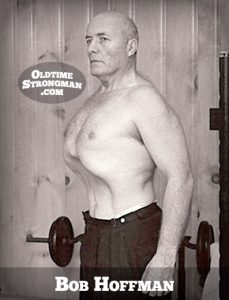
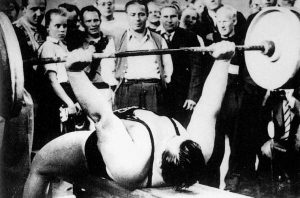

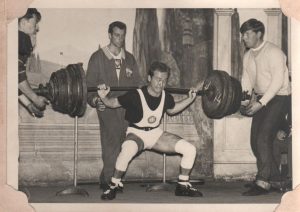
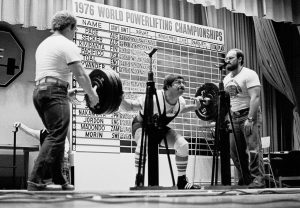
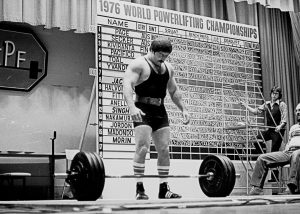
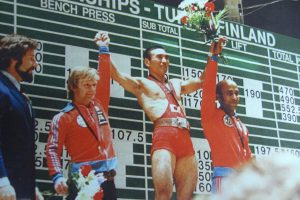
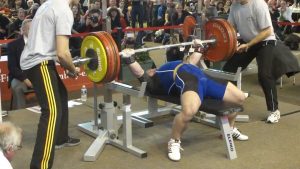
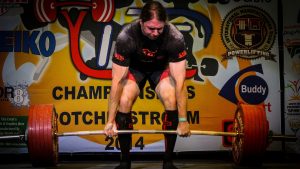
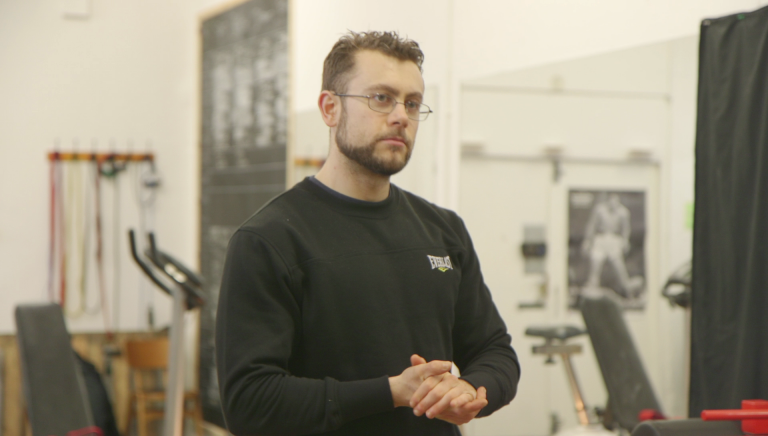
frank howgate
April 13, 2022 at 12:26 pmin my early years of weightlifting I did the strength set and then moved on to the power lifts I was priveledged to lift in a match with the great ron Collins on the reg park show in Manchester a few years back I also heiped Arnold swarzenneger pump up his biceps in a show in harworth-memories .
Ted Lite
May 30, 2022 at 1:00 pmBest lifter I remember was some crazy American that showed at a meet in Toronto as a guest lifter in 1982. Can’t recall his name. I do know he squatted 300 KG, benched 235 KG and deadlifted 365 KG as a 90 KG lifter wearing only a belt and a singlet. I heard he died in a farm accident in Minnesota a few months after this meet. The guy had long blonde surfer hair and wore John Lennon glasses. And wore a Thor’s hammer around his neck. I remember this “Christian” lifter commenting on this lifter displaying a “pagan” symbol on a chain. The crazed lifter replied, “the son of your god hangs on a cross, the son of my god carries a hammer”. LOL
Joe Onorati
March 17, 2023 at 10:48 pmYou might be talking about Gerald(Jerry) Jones he was a 90kg lifter from Minnesota he competed in many national meets and an Hawaiian power meet in 1980 and an IPF in 1973 meet he passed in the year 2000.
Kelly Jones
February 11, 2025 at 3:11 amJerry is my dad. Warms my heart to stumble across this post, so many years after his passing. Recently heard Ricky Dale Crain passed. Another great from that era.
frank howgate
March 20, 2023 at 11:23 ami had the pleasure of lifting alongside ron collins on more than one occasion and would like to get in touch-can you or anyone help me to do so >
TaylorsStrength
March 21, 2023 at 12:50 pmHi Frank,
I’ll follow this response up with an email to you.
Cheers,
Danny
frank howgate
March 20, 2024 at 4:14 pmstill waiting for a response -ron must be close on 90 by now ?
frank howgate
June 1, 2023 at 2:40 pmstill waiting for news on how to contact ron collins can anyone help frank howgate